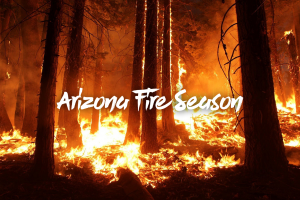[vc_row][vc_column][vc_column_text responsive_align=”left”]
Tinder Fire hits close to home
Make sure you have a fire safety plan in place during Arizona fire season
James Taylor CFP® , Wealth Counselor
, Wealth Counselor
Arizona’s recent Tinder Fire started near Blue Ridge Reservoir, located an hour or so north of Payson on Highway 87. High winds and dry forest fueled the flames in a northeasterly direction along East Clear Creek Canyon. Photos of the fire showed bright red plumes and smoke billowing towards the sun.
My parents called the morning after news broke about the blaze to let me know the fire was heading toward the neighborhood where they have a cabin. We watched the news, constantly checked the fire map on InciWeb, looked at the Twitter search #tinderfire, and talked on the phone with local firefighters. The neighborhood was evacuated, and things were looking bleak.
My parents had spent the past two years building the cabin from the ground up – mostly by themselves. They put the finishing touches on it in the spring and now faced the prospect of it burning to the ground. We hoped and prayed that the men and women risking their lives to fight the fire would be safe and the cabin would survive. As luck would have it, the forest and firefighters caught a break. A rare, late April snowstorm came through and dropped a few inches of moisture in the area of the fire. The next day it rained and humidity levels drastically increased. The winds calmed down, and the firefighters were able to get the flames under control. It turned out, the fire came within one street of my parents’ cabin. Many others weren’t so fortunate, with more than forty homes and many small structures having been destroyed.
This story is a reminder that fire season is upon us and with the low rainfall and snowfall in Arizona this year, the forests are especially dry. One act of carelessness can result in devastating consequences. Fortunately, the Tinder Fire did not get out of control, and no one lost their lives fighting it.
It is important to review insurance coverages on your properties at least annually to protect yourself against a catastrophic loss. Important things to consider are:
• The levels of coverage on your home, detached structures, and contents should reflect the current value. Review your coverage limits with your agent. Keep in mind that if a wildfire destroys many homes in the area, the cost of rebuilding will be at a premium due to supply and demand.
• Make sure your policy provides coverage for wildfires. Coverage may vary by geographic location, especially in areas susceptible to wildfires.
• Review your policy to ensure you are covered for smoke and ash damage.
• Most policies have limits on fire service fees. Find out what your policy covers if you receive a service bill from the fire department.
• There are limits on coverage for plants — typically, $500 per plant (including the cost to remove it). For example, if you have a tall majestic ponderosa pine tree on your property, chances are it will not be fully covered. The maximum for all plants combined is generally 5% of your main structure coverage limits.
Most importantly, it is our responsibility to keep the forests safe so everyone can enjoy them for many years to come and keep firefighters out of harm’s way.
The National Fire Protection Association website offers the following wildfire safety tips for your home:
• Clear leaves and other debris from gutters, eaves, porches and decks. This prevents embers from igniting your home.
• Remove dead vegetation and other items from under your deck or porch, and within 10 feet of the house. Learn more about the basics of defensible space on the Firewise website.
• Screen or box-in areas below patios and decks with wire mesh to prevent debris and combustible materials from accumulating.
• Remove flammable materials (firewood stacks, propane tanks) within 30 feet of your home’s foundation and outbuildings, including garages and sheds. If it can catch fire, don’t let it touch your house, deck or porch.
• Wildfire can spread to tree tops. Prune trees so the lowest branches are 6 to 10 feet from the ground.
• Keep your lawn hydrated and maintained. If it is brown, cut it down to reduce fire intensity. Dry grass and shrubs are fuel for wildfire.
• Don’t let debris and lawn cuttings linger. Dispose of these items quickly to reduce fuel for fire.
• Inspect shingles or roof tiles. Replace or repair those that are loose or missing to prevent ember penetration.
• Cover exterior attic vents with metal wire mesh no larger than 1/8 inch to prevent sparks from entering the home.
• Enclose under-eave and soffit vents or screens with metal mesh to prevent ember entry.
• Learn more about how to protect your home and property at Firewise.org.
Also, learn how to properly choose a campfire location, start your fire, and safely extinguish it. Happy camping, hiking, and exploring. Be safe!
James Taylor, CFP®
Wealth Counselor
James helps to oversee asset and portfolio management for Versant Capital Management’s clients, working to ensure that their financial plans are optimized to succeed.
[mk_fancy_text color=”#444444″ highlight_color=”#ffffff” highlight_opacity=”0.0″ size=”14″ line_height=”21″ font_weight=”inhert” margin_top=”0″ margin_bottom=”14″ font_family=”none” align=”left”]Disclosure: Please remember that past performance may not be indicative of future results. Different types of investments involve varying degrees of risk, and there can be no assurance that the future performance of any specific investment, investment strategy, or product (including the investments and/or investment strategies recommended or undertaken by Versant Capital Management, Inc.), or any non-investment related content, made reference to directly or indirectly in this newsletter will be profitable, equal any corresponding indicated historical performance level(s), be suitable for your portfolio or individual situation, or prove successful. Due to various factors, including changing market conditions and/or applicable laws, the content may no longer be reflective of current opinions or positions. Moreover, you should not assume that any discussion or information contained in this newsletter serves as the receipt of, or as a substitute for, personalized investment advice from Versant Capital Management, Inc. To the extent that a reader has any questions regarding the applicability of any specific issue discussed above to his/her individual situation, he/she is encouraged to consult with the professional advisor of his/her choosing. Versant Capital Management, Inc. is neither a law firm nor a certified public accounting firm and no portion of the newsletter content should be construed as legal or accounting advice. If you are a Versant Capital Management, Inc. client, please remember to contact Versant Capital Management, Inc., in writing, if there are any changes in your personal/financial situation or investment objectives for the purpose of reviewing/evaluating/revising our previous recommendations and/or services. A copy of the Versant Capital Management, Inc.’s current written disclosure statement discussing our advisory services and fees is available upon request.[/mk_fancy_text][/vc_column_text][/vc_column][/vc_row]
